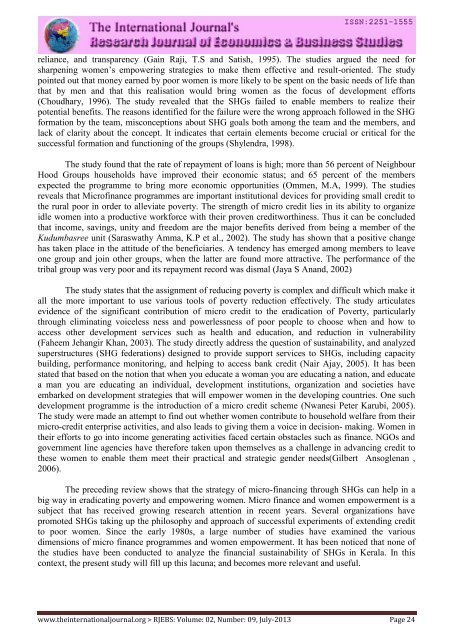Research Journal of Economics & Business Studies - RJEBS - The ...
Research Journal of Economics & Business Studies - RJEBS - The ...
Research Journal of Economics & Business Studies - RJEBS - The ...
You also want an ePaper? Increase the reach of your titles
YUMPU automatically turns print PDFs into web optimized ePapers that Google loves.
eliance, and transparency (Gain Raji, T.S and Satish, 1995). <strong>The</strong> studies argued the need for<br />
sharpening women’s empowering strategies to make them effective and result-oriented. <strong>The</strong> study<br />
pointed out that money earned by poor women is more likely to be spent on the basic needs <strong>of</strong> life than<br />
that by men and that this realisation would bring women as the focus <strong>of</strong> development efforts<br />
(Choudhary, 1996). <strong>The</strong> study revealed that the SHGs failed to enable members to realize their<br />
potential benefits. <strong>The</strong> reasons identified for the failure were the wrong approach followed in the SHG<br />
formation by the team, misconceptions about SHG goals both among the team and the members, and<br />
lack <strong>of</strong> clarity about the concept. It indicates that certain elements become crucial or critical for the<br />
successful formation and functioning <strong>of</strong> the groups (Shylendra, 1998).<br />
<strong>The</strong> study found that the rate <strong>of</strong> repayment <strong>of</strong> loans is high; more than 56 percent <strong>of</strong> Neighbour<br />
Hood Groups households have improved their economic status; and 65 percent <strong>of</strong> the members<br />
expected the programme to bring more economic opportunities (Ommen, M.A, 1999). <strong>The</strong> studies<br />
reveals that Micr<strong>of</strong>inance programmes are important institutional devices for providing small credit to<br />
the rural poor in order to alleviate poverty. <strong>The</strong> strength <strong>of</strong> micro credit lies in its ability to organize<br />
idle women into a productive workforce with their proven creditworthiness. Thus it can be concluded<br />
that income, savings, unity and freedom are the major benefits derived from being a member <strong>of</strong> the<br />
Kudumbasree unit (Saraswathy Amma, K.P et al., 2002). <strong>The</strong> study has shown that a positive change<br />
has taken place in the attitude <strong>of</strong> the beneficiaries. A tendency has emerged among members to leave<br />
one group and join other groups, when the latter are found more attractive. <strong>The</strong> performance <strong>of</strong> the<br />
tribal group was very poor and its repayment record was dismal (Jaya S Anand, 2002)<br />
<strong>The</strong> study states that the assignment <strong>of</strong> reducing poverty is complex and difficult which make it<br />
all the more important to use various tools <strong>of</strong> poverty reduction effectively. <strong>The</strong> study articulates<br />
evidence <strong>of</strong> the significant contribution <strong>of</strong> micro credit to the eradication <strong>of</strong> Poverty, particularly<br />
through eliminating voiceless ness and powerlessness <strong>of</strong> poor people to choose when and how to<br />
access other development services such as health and education, and reduction in vulnerability<br />
(Faheem Jehangir Khan, 2003). <strong>The</strong> study directly address the question <strong>of</strong> sustainability, and analyzed<br />
superstructures (SHG federations) designed to provide support services to SHGs, including capacity<br />
building, performance monitoring, and helping to access bank credit (Nair Ajay, 2005). It has been<br />
stated that based on the notion that when you educate a woman you are educating a nation, and educate<br />
a man you are educating an individual, development institutions, organization and societies have<br />
embarked on development strategies that will empower women in the developing countries. One such<br />
development programme is the introduction <strong>of</strong> a micro credit scheme (Nwanesi Peter Karubi, 2005).<br />
<strong>The</strong> study were made an attempt to find out whether women contribute to household welfare from their<br />
micro-credit enterprise activities, and also leads to giving them a voice in decision- making. Women in<br />
their efforts to go into income generating activities faced certain obstacles such as finance. NGOs and<br />
government line agencies have therefore taken upon themselves as a challenge in advancing credit to<br />
these women to enable them meet their practical and strategic gender needs(Gilbert Ansoglenan ,<br />
2006).<br />
<strong>The</strong> preceding review shows that the strategy <strong>of</strong> micro-financing through SHGs can help in a<br />
big way in eradicating poverty and empowering women. Micro finance and women empowerment is a<br />
subject that has received growing research attention in recent years. Several organizations have<br />
promoted SHGs taking up the philosophy and approach <strong>of</strong> successful experiments <strong>of</strong> extending credit<br />
to poor women. Since the early 1980s, a large number <strong>of</strong> studies have examined the various<br />
dimensions <strong>of</strong> micro finance programmes and women empowerment. It has been noticed that none <strong>of</strong><br />
the studies have been conducted to analyze the financial sustainability <strong>of</strong> SHGs in Kerala. In this<br />
context, the present study will fill up this lacuna; and becomes more relevant and useful.<br />
www.theinternationaljournal.org > <strong>RJEBS</strong>: Volume: 02, Number: 09, July-2013 Page 24
















